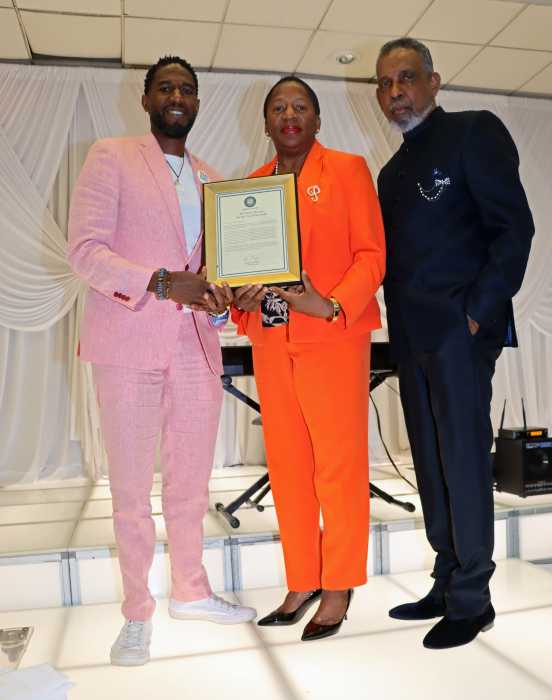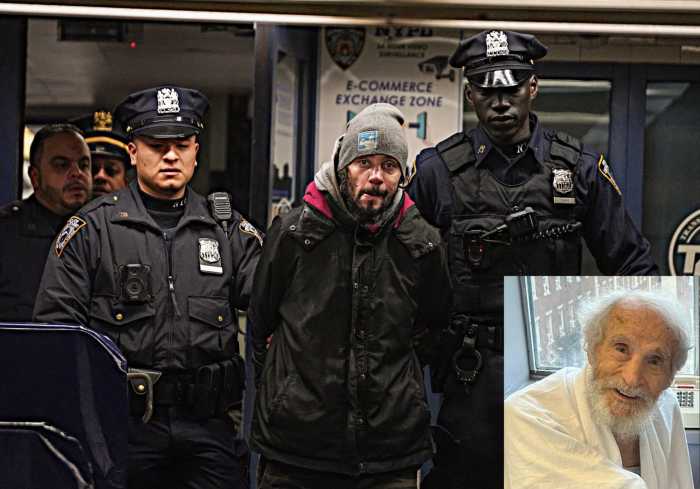Paterson’s Patois, The Rhythm of Rosene, Gun Play in Queens
“Vincent Paterson: Master of All Media” at the Walter Reade Theatre on January 13 celebrated the career of the most influential American choreographer of the last 20 years. I say this on the particular strength of his work with Madonna and Michael Jackson, for it was Paterson who came up with, for Madonna, the choreography for her “Blonde Ambition” tour, which included the moves for “Vogue” and the Fosse-meets-“Clockwork Orange” “Keep It Together,” and, for Jackson, the videos “The Way You Make Me Feel,” “Black or White,” and “Smooth Criminal.”
Pennsylvania-born Paterson was thrown out of ballet class as a youngster but persevered as a dancer, and, when it came time to audition for Michael Jackson’s “Beat It” video, did so, as an actor, rather than a dancer, dressing like a gang member, rather than the usual tights and leg warmers. Jackson said, “I like him,” and a friendship was forged, with Paterson quickly graduating to full director of the star’s videos.
At the tribute, Paterson remarked upon the violence in “Smooth Criminal,” saying, “I’m a very peaceful, save the whales kind of guy. All that killing and darkness was Michael’s idea.” A never-seen alternate version of Jackson’s “Blood on the Dance Floor” video which Paterson shot with an 8mm camera––grainy, overexposed, and sexy as shit––was shown, and Paterson said, “Michael loved it, but Sony hated it and refused to release it, which is where all the trouble might have started.”
Paterson met Madonna on the set of a Pepsi commercial. “I don’t need a choreographer,” she haughtily told him, brushing him aside, but he described saving the day when they were having difficulty filming a particular dance move, by suggesting certain camera angles and timing. Later, while working with the chorus, Paterson said, “All the kids suddenly stopped what they were doing and were staring at Madonna, who appeared in curlers and a robe and jumped into the number, because she wanted to learn the moves.”
Paterson went on to choreograph Madonna’s “Evita.” The famous 1990 MTV Awards clip of her doing “Vogue,” dressed in the rococo gown Michelle Pfeiffer wore in “Dangerous Liaisons,” was also shown, a dance which was triumphantly brought off live, despite Madonna’s initial resistance to its incorporation of fans.
Paterson’s film work includes “The Birdcage,” with that hilarious dance history collage performed by Robin Williams. “Mike Nichols had such a hard time, keeping Robin down during the filming,” he recalled. “Nathan Lane was supposed to be the flamboyant character, but, for the audition scene, Robin came to me and said, ‘You gotta give me something!’ I said, ‘Give me a minute,’ and in 10 minutes on the set came up with the history of dance in 10 seconds for him.”
Intriguing rehearsal footage of the train number from Lars von Triers’ “Dancer in the Dark” was screened, with Paterson recalling, “Lars told me, ‘I hate Bjork’s music.’ ‘Well, I love it,’ I said. She was just fearless, doing any dangerous thing I asked her to.” Paterson even stood up to the formidable von Trier, contradicting him, when the director said there was to be no camera movement in the numbers, by pointing out a shot of Bjork dancing on the ceiling. “Nobody talks to me like this!” von Trier screamed, but it was for that very reason that Paterson was kept on the project, and given even more creative power.
Paterson, who prefers to be called a director, rather than a choreographer, wants to do more live theater. “I didn’t know anything more about opera than, um Callas,” he said, “but [Russian soprano] Anna Netrebko loved my work on MTV and contacted me about doing a DVD of five different opera arias with her.” The DVD, “Anna Netrebko––The Woman, The Voice,” was a prize-winning smash, and has led to Paterson’s directing her in “Manon,” for Los Angeles Opera with her real life lover, tenor Rolando Villazón, next September.
Paterson, endearingly humble, kept repeating how lucky he was to have the early support of Madonna and Jackson––I think they were lucky to have him, as neither has ever stopped their work with him––and said, “This tribute is overwhelming. I never expected to see so many friends and family, except at my wedding or funeral. As I am still not able to marry my male partner of 30 years, this is incredible!”
No one loves the music of the ‘20s to the ‘40s as much as Barbara Rosene, and her show at Danny’s Skylight Room, seen January 17, was lilting, scintillating. With James Gelber rocking the stride piano and Michael Hashim’s richly textured sax, Rosene delivered a show of songs devoted to the moon, all of them winners, but very few, apart from “Moonglow” and “Paper Moon,” all that familiar. These gems had a first-hearing catchiness and pure lovability that seemed the easy province of so many songwriters of that era, and Rosene’s plangent soprano made the most of fetchingly witty lyrics by such as Sam Coslow, Edward Heyman and Dorothy Parker.

Rosene is a lovely mimic, as well, and her impressions of Helen Kane and Ruth Etting delighted. Kane (1903-66) was the original boop-a-doop girl, the prototype of Betty Boop herself, with her adorable Bronx-accented baby squeal, and Etting (1896-1978), one of the greatest torch singers, had a nasal warmth and homey diction that Rosene captured perfectly. (“Ruth, [Our Gang’s] Darla Hood, and Ethel Merman, they’re really all the same impression,” she confided to me later.)
When you see a Rosene show, you’ll get a bracingly undidactic dose of music history, as when she describes “Hello, Everybody,” a 1933 movie aimed at turning hefty Kate Smith into a star opposite the “athletic, chiseled [and gay] Randolph Scott,” before launching into a meltingly aristocratic rendition of Smith’s “Moon Song.” Rosene plays again on January 31, and her show has been extended through February.
Rosene’s preferred era of sweet serenades under the moonlight seems even further away when juxtaposed against something like “Gun Play,” at the cunning, if rather uncomfortable, Long Island City performance space Chocolate Factory, seen January 19. Inspired by the musings of John Carmack, champion of the first person shooter video game, it was an elaborate performance piece that rather simulated Carmack’s 1993-invented game Doom.
A battery of computers, projection screens, and digital video cameras arranged around a coolly stark white space abetted the five actors, playing real-life, gun-obsessed characters like rocker Ted Nugent, Hunter Thompson, Clint Eastwood, and Carmack, himself. At other times, the performers morphed into wordless elements of a video game, hurling themselves against mattressed walls––an effect that, while initially powerful, quickly became monotonous through overuse.
The synchronized technology of the piece, conceived and directed by Brian Rogers, was impressive, the content much less so, as a tiresome cryptic quality and willfully deliberate obfuscation seemed the overall aim here. And some of the performers, while physically adroit, were less strong in the verbal department, spouting lines like, “I don’t think there’s a silver bullet for parallel programming,” either too quickly or in impenetrable accents. A possibly lethal game of musical chairs was also presented at one point in this meditation on the alienation and the absurdity of modern society.
Contact David Noh at Inthenoh@aol.com.
Courtesy The Film Society of Lincoln Center
Influential film and video director Vince Paterson, the subject of a documentary screened at Dance on Camera, is perhaps best known for his work with Madonna and Michael Jackson.
gaycitynews.com




































